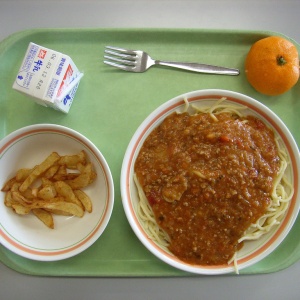
This summary has been provided by FCRN member Alessandro Cerutti from the European Commission Joint Research Centre (JRC).
Public administrations such as schools, hospitals and other sectors are well aware of the effort required to manage all the stages of the catering service, from menu selection through to waste management. Several strategies hold potential to reduce the environmental impacts throughout these stages, especially in the context of the Green Public Procurement (GPP). Unfortunately, despite the best of intentions, budget constraints are constantly forcing managers to make difficult trade-offs.
Therefore, this paper aims to provide an answer to the question of how a municipality should assess possible Green Public Procurement (GPP) practices for the catering service to determine the best way to reduce the emissions of greenhouse gases. In order to answer this question, a baseline-catering scenario is first defined with a quantification of GHG emissions (in terms of CO2 equivalents) is established; the potential impact reductions of each identified GPP policy are then calculated and compared with the baseline scenario. This way, each GPP policy can be assessed and different practices can be ranked to determine the most effective ones. The baseline-catering scenario is based on the case study of the school catering service in the city of Turin (Italy). A Life Cycle Assessment approach is used to calculate emissions. The simplified LCA used a farm-to-plate approach and therefore includes emissions from production, transport, cooking, and waste from packaging.

The results show that food production generates the highest impacts, contributing 78% of the Climate Change potential of the full catering service. This impact can primarily be attributed to the meat component of the average meal, which covers around the 39% of the Climate Change potential of the full service. Emissions at the transport phase are lower than expected (around 3% of the full catering service). Besides food production, another relevant point of emissions is the electricity used in the cooking facilities and school canteens, which contributes around 6% of the GHG impacts of the catering service.
The paper describes the emission reduction possible from adoption of 11 different GPPs and analyses the challenges in doing so for the school catering service in the city of Turin. Unfortunately, the GPP policies that lead to the highest potential reductions are also those that are more difficult to apply. Moving to a vegetarian diet could for example reduce emissions by 32% but, although the decrease of meat consumption is supported by the World Health Organisation, a complete shift to a vegetarian diet would be considered very controversial from a nutritional point of view. Besides GPPs that target food production systems, the second major area of improvement is waste management. All considered GPP policies that affect this part of the life cycle could be applied with relatively low effort by the caterer, but if summed, could potentially lead to a reduction of around 10%. The report concludes by saying that a life-cycle based approach, despite the complexity and uncertainty of modelling, is an essential prerequisite to developing sustainable strategies for green public procurement.
Abstract
Purpose. Several scientific papers and technical reports have discussed the role of green public procurement in the food sector. Different strategies for the restoration sector have been identified. However, there is not yet a common understanding of which policies could be the most efficient in reducing the global warming potential of the public restoration service. This paper assesses a set of procurement policies, ranking them according to their potential to reduce the greenhouse gas emissions of public catering.
Methods. Eleven relevant green public procurement policies were identified from the literature. These are discussed in the context of a case study of the school catering service in the city of Turin (Italy). Initially, a life cycle approach is applied to a baseline scenario of the collective restoration system of the city, to quantify the quantity of greenhouse gases produced by the entire catering service (including all stages from the production of food to the management of waste from kitchens and canteens). Afterwards, the 11 policies were applied to the baseline scenario so that the potential improvement achieved by each policy could be quantified.
Results and discussion. The baseline scenario resulted in 1.67 kgCO2eq per average meal. The production of food dominates the global warming potential of the full service, being responsible for about 78% of the greenhouse gas emissions. Among the selected policies, a change in diet was the most effective (leading to a 32%reduction of the CO2eq emissions), followed by the adoption of improved food production practices (11% reduction) and the purchasing of certified green electricity (6% reduction).
Conclusions. The proposed method allows the assessment of procurement policies in the catering service by applying a simplified life cycle approach that considers all the stages of the process. Public authorities and other stakeholders could benefit from basing their decisions upon scientific evidence and avoiding the prioritisation of policies based on personal opinions or weak evidence. Uncertainties and areas for improvement in the method have been also identified for future investigation.
Reference
Cerutti, A. K., Ardente, F., Contu, S., Donno, D., & Beccaro, G. L. (2017). Modelling, assessing, and ranking public procurement options for a climate-friendly catering service. The International Journal of Life Cycle Assessment, INPRESS 1-21.
Read the full paper here (open access).
Do you want to submit research/events/jobs to be included in Fodder? Fill in this online form.







Post a new comment »